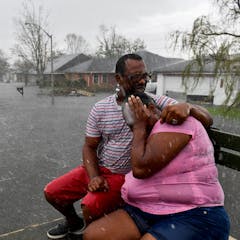
Articles on Heat wave
Displaying 61 - 80 of 183 articles

The UK recorded blistering hot temperatures as the US and Europe also experienced sweltering heat waves.

Governments and organizations must listen to older adults’ experiences with extreme heat, flooding and wildfire smoke to create effective policies and programs

Summer sports camps and pre-season training often have kids running hard in high heat and humidity. The combination can be deadly.

New research on young, healthy humans found the body begins overheating when exposed to temperatures and humidity lower than previously believed.

Climate change has a clear link to rising foodborne illnesses. Blackouts during heat waves and wildfires are a growing part of the problem.

As crops fail in the rising heat, men are leaving many rural areas for migrant work in cities. Women are left to tend to the farming in increasingly dangerous conditions.

Heat domes are a dangerous part of summer weather. Millions of Americans are facing exceptionally high temperatures going into summer 2024.

Extreme heat waves are putting lives in danger, with some of the hottest urban neighborhoods 10 degrees hotter or more than their wealthier neighbors. Often, these are communities of color.

During heatwaves, the highest temperatures are often found in urbanized areas. Small green spaces are often overlooked as a way to cool urban areas.

La Niña is only part of the problem. The long-term driver of increasing drought – even in areas getting more rainfall overall – is the rapidly warming climate.

Beekeepers in British Columbia reported honeybee deaths during the 2021 heat dome. Other insects may also be at risk.

Emission of greenhouse gases is on the rise, an indication that the worst lies ahead.

The risk from heat waves is about more than intensity – being able to cool off is essential, and that’s hard to find in many low-income areas of the world.

While surface temperatures were about the 6th warmest on record in 2021, the upper oceans were at their hottest – and they’re a stronger indicator of global warming. A top climate scientist explains.

A hurricane that wreaked havoc from Louisiana to New York City, the Texas freeze and devastating western wildfires topped NOAA’s list of billion-dollar disasters in 2021.

US disasters in 2021 told a tale of two climate extremes. A climate scientist explains why wet areas are getting wetter and dry areas drier.

Southern California is on the front line of climate change, and recent survey data shows that residents are feeling its effects in many ways.

Studies show climate change is raising the risk of cascading hazards that alone might not be extreme but add up to human disasters. Communities and government agencies aren’t prepared.

More than half of the world’s population lives in cities, and that share is growing. Rapid climate change could make many cities unlivable in the coming decades without major investments to adapt.

Hot, humid population centers are becoming epicenters of heat risk as climate changes worsens. It’s calling into question the conventional wisdom that urbanization uniformly reduces poverty.
